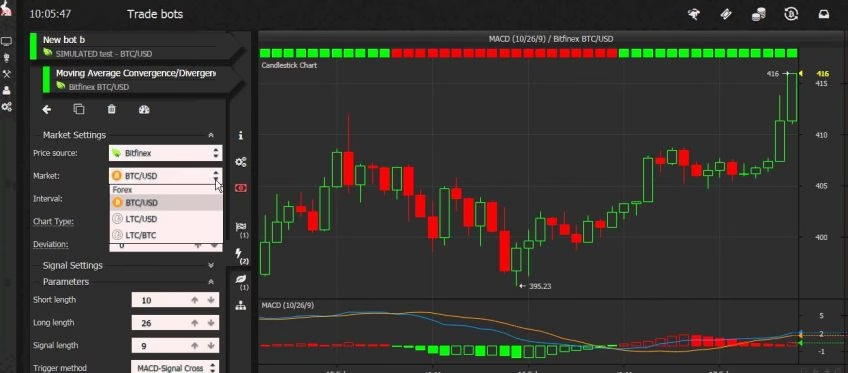Since different timeframes provide distinct perspectives and prices, backtesting is essential to ensure that a trading plan is dependable. Testing a strategy on various time frames lets traders to gain an idea of how it performs in different market conditions. It also allows you to decide if the strategy is constant and reliable over the course of time. A strategy that is successful over a daily period may not perform as well on longer time frames, such as weekly or monthly. Backtesting the strategy on both daily and weekly timesframes allows traders to identify potential problems and then adjust the strategy according to the results. Backtesting with multiple timeframes also offers the benefit in helping traders choose the most appropriate timeframe to implement their strategy. Backtesting can be useful for different traders with different trading strategies. You can test backtesting on different timeframes, and assist in determining the best time horizon. Backtesting across multiple time frames allows traders to gain a deeper comprehension of the strategy's performance and lets them make better informed decisions about the reliability and consistency of the strategy. See the recommended algorithmic trade for blog info including trade indicators, backtesting platform, forex trading, cryptocurrency trading, algo trading platform, best crypto trading bot, free crypto trading bot, backtesting tradingview, best backtesting software, trading with indicators and more.

For Speedy Computation, Why Not Backtest Multiple Timeframes?
It is not always faster to run backtests over multiple timeframes. However one-time backtesting is able to be done just as quickly. Backtesting in multiple timeframes serves two purposes: to test the strength of the strategy, and also to ensure that it's reliable across various times and market conditions. Backtesting multiple timesframes is the practice of testing the same strategy on various timeframes (e.g. daily or weekly, and even monthly) and then analyzing the outcomes. This gives traders a greater comprehension of the strategies performance, and aid in identifying potential weak points or inconsistencies. However, it's important to keep in mind that backtesting using different timeframes could increase the complexity and time requirements of the backtesting process. There are trade-offs to be made between the benefits of backtesting on multiple timesframes and the extra computational and time requirements should be carefully thought through by traders while backtesting on multiple timeframes. This is because it will help to determine the reliability of a strategy and also ensure that it works consistently across different market conditions. When backtesting on multiple timeframes, investors must evaluate the potential benefits versus the additional time and computational demands. Follow the top backtesting trading strategies free for site examples including stop loss order, backtesting trading strategies, stop loss meaning, crypto trading backtester, cryptocurrency trading, stop loss meaning, rsi divergence cheat sheet, algo trading platform, backtesting tradingview, automated trading bot and more.

What Are Backtest Considerations Regarding Strategy Type, Element And The Number Of Trades
It is crucial to take into consideration various aspects when backtesting trading strategies. These factors can have an effect on the outcomes of backtesting a trading strategy. It is important to understand the type of strategy that is being tested to select historic market data that is suitable for the particular strategy.
Strategies' elements can have a major impact on the outcome of backtesting. This includes the rules for entry and exit as well as position sizing. It is crucial to evaluate the performance of the strategy and make any changes to ensure it is strong and solid.
The number of trades. The process of backtesting can affect the results. While having a higher quantity of trades can provide an overall view of the strategy's performance it could also add to the computational burden of the backtesting. A lesser number could enable faster backtesting, but not provide a comprehensive view of the strategy’s performance.
In conclusion the backtesting process, it is a matter of considering the strategy type, strategy elements, and the number of transactions. This will ensure accurate and reliable outcomes. These aspects can assist traders evaluate the strategy's effectiveness and make informed decisions regarding its validity. Follow the best position sizing trading for site examples including backtesting platform, best free crypto trading bot, backtesting trading, algo trading platform, algo trading software, forex backtesting software, psychology of trading, backtesting trading strategies, how does trading bots work, forex backtesting software free and more.
What Are The Criteria That Have Been Approved Regarding The Equity Curve, Its Performance And Number Of Trades
Backtesting is a method for traders to assess the effectiveness of a trading system. It is possible to utilize a variety of factors to determine if the system succeeds or fails. These criteria can be the equity curve, performance indicators and the amount of trades.Equity Curve - The equity curve is a graphic that shows the development of a trading account over time. This is an important indicator of a trading strategy's overall performance. This criterion can be passed in the event that the equity curve displays steady growth over a long period of time with very minimal drawdowns.
Performance Metrics: Aside from the equity curve, traders may consider other performance indicators when evaluating trading strategies. The most commonly used metrics include the profit factor, Sharpe rate, maximum drawdown, the average time to trade and the maximum profits. The criteria can be satisfied if the strategy's performance indicators are within acceptable ranges and also if they demonstrate consistency and reliability over the backtesting time.
The number of trades is a key criterion for evaluating the strategy's performance. If a strategy is able to generate enough trades in the backtesting time to provide a complete picture of its performance, it might be thought to meet this criteria. It is crucial to keep in mind that just because a strategy produces a large number of trades it does not necessarily mean that it is effective. Other aspects such as the quality and quantity of trades have to be taken into consideration.
The equity curve and performance metrics, as well as trades, and the number of trades are all crucial elements in evaluating the performance of a trading strategy through backtesting. These will help traders make educated decisions on whether the strategy is durable and reliable. With these parameters, traders can better assess the performance of their strategies and make needed changes to improve their performance.